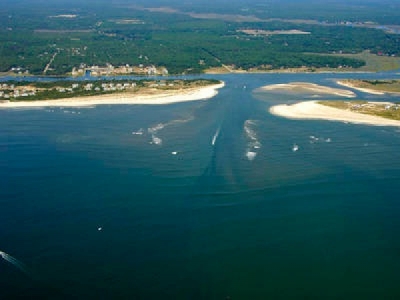
Posted on April 10, 2018
By Lee Hinnant, stateportpilot.com
The U.S. Army Corps of Engineers special purpose dredge Currituck has finished opening Lockwood Folly Inlet and officials report the channel is straighter and deeper than it’s been in a decade.
Jim Medlock, shallow draft inlet navigation program project manager for the corps’ Wilmington District, said the job cost about $480,000 to $500,000, less than the $580,000 budgeted. The state’s shallow draft inlet fund paid for two-thirds, with the remainder split between Brunswick County and Holden Beach.
Heavily used by commercial fishermen, charter fishing guides and recreational boaters, the inlet was so badly shoaled that the U.S. Coast Guard removed the 10 navigational buoys in April 2017.
Two corps dredges worked the inlet last summer, but the relief was short-lived when Hurricane Irma blew through in September, pushing sand into the outer reach of the channel.
“It’s a very active channel,” Medlock told members of the Brunswick Shoreline Protection group last Wednesday. “It’s been slow in coming, but we believe we’ve got something that’s effective.”
A recent survey by two members of Oak Island Water Rescue showed that the channel is relatively narrow near the shipwreck Bendigo, which is visible at low water. There are four other shipwrecks in the vicinity.
Water Rescue members also noted that the channel between Oak Island and Holden Beach drops off very quickly to about 20 feet. It also can have swift currents. They advise non-swimmers to avoid going in the water in that area. It’s much safer to get in the water on the beach or in the shallows on the landward side around Eastern Channel.
While most of the main Lockwood Folly channel is back to its federally authorized depth of 14 feet, Eastern Channel is badly shoaled there and practically impassable to all but kayaks or paddleboards. It’s still possible, however, to access the Lockwood Folly Inlet or Intracoastal Waterway from the channel just west of Sheep Island.
Medlock said the recent work also included removing sand from the Shallotte Inlet crossing of the Intracoastal Waterway.
The corps has informed the Coast Guard of the dredging but Medlock said it was not yet known when the navigational buoys would be repositioned. He said the buoy tender Bayberry, based at Caswell Beach, was responsible for aids to navigation along much of the East Coast and not always readily available.
Source: stateportpilot.com





